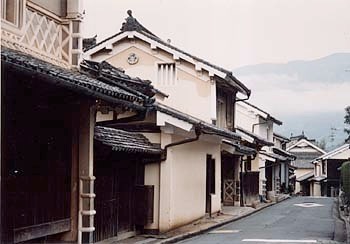































However, my major objective in this area was not Ozu but another small town: Uchiko. If you can only visit one small town on Shikoku, you should make it this one. Part of the town is a typical small mountain town with shopping arcades and so on. But entire sections of it have been perfectly preserved - not like a museum, but similar to Hida-Takayama, as a living museum, where people still reside and where traditional crafts are still alive. The candle shop may be the only place where Japanese candles are still made using the traditional method.
Uchiko offers endless photo opportunities. This building has been converted into a coffee shop and restaurant, with a water wheel turning in the garden outside. Next door, I noticed huge bamboo panels in front of a gate, so I asked what traditional craft they represented. "Oh, nothing special," came the reply. "We just put those together so people wouldn't illegally park there." As I said, a living culture - and in that respect very similar to Hida-Takayama.



